The debate has raged on for years among dog enthusiasts and breeders: Are American Pit Bull Terriers and Staffordshire Bull Terriers, commonly known as Pit Bulls and Staffies, indeed the same breed?
Their strikingly similar appearances and shared histories make it easy to see why they’re often mistaken for one another.
In this article, we’ll delve deep into these two beloved breeds’ origins, characteristics, and distinctions, shedding light on a question that has puzzled many for decades.
Are Staffies Pit Bulls?
Pitbulls and Staffies are not the same. “Pit Bull” is a general term for a type of dog, often referring to the American Pit Bull Terrier. “Staffies” or Staffordshire Bull Terriers are a specific breed. Both share a common ancestry but have distinct characteristics and histories.
But…
- Some people will tell you that both are the same breed.
- Others will tell you that the two dogs are very distinct breeds.
So why the confusion??
To understand why there is so much confusion between Pit Bulls and Staffies, we must take a look back into their history.
Ready to get started?
Start Watching (or Reading):
[youtube id=”NCnPC7p3GMk”]
Quick Comparison:
Staffordshire Bull Terrier vs. Pitbull Differences Chart
| Feature/Characteristic | Staffordshire Bull Terrier | American Pit Bull Terrier |
|---|---|---|
| Origin | United Kingdom | United States |
| Size | Medium | Medium to Large |
| Weight | 24-37 lbs (11-17 kg) for males; 24-34 lbs (11-15.4 kg) for females | 30-85 lbs (13.6-38.5 kg) depending on gender and individual genetics |
| Height | 14-16 inches (36-41 cm) | 17-21 inches (43-53 cm) |
| Lifespan | 12-14 years | 12-16 years |
| Coat | Short and smooth | Short and smooth |
| Color Varieties | Black, blue, fawn, red, white, or any of these colors with white | Wide range including brindle, black, red, fawn, blue, white, and combinations |
| Temperament | Affectionate, bold, fearless, and loyal | Loyal, affectionate, confident, and gentle with family |
| Exercise Needs | Moderate | High |
| Training | Responsive but can be stubborn | Highly trainable but requires a firm hand |
| Good with Children | Yes, known to be very good with children | Generally yes, but early socialization is crucial |
| Health Concerns | Hip dysplasia, cataracts, and respiratory issues | Hip dysplasia, heart disease, and hereditary cataracts |
While this table provides a general comparison, individual dogs may vary.
Historical Origins
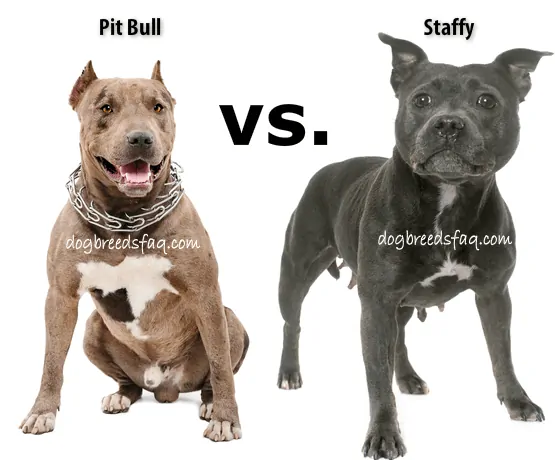
One of the main reasons that Pit Bulls and Staffies share so many similarities is because both breeds can be traced back to the same bloodline.
In the late 1700s, the British crossbred Bulldogs and Black & Tan Terriers, and the result were the Staffordshire Bull Terriers[1].
During the 19th century, again, the Brits began breeding Old English bulldogs with Old English Terriers in hopes of creating a breed with bulldogs’ power and athletic abilities and the “gameness” of terriers.
The result was a new breed of dogs referred to as “Bull and Terrier[2]”
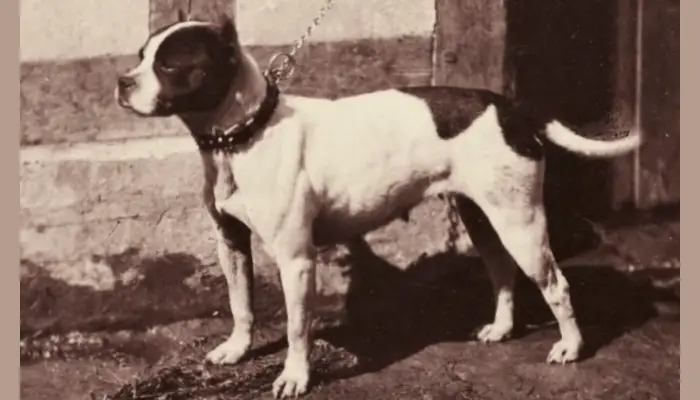
Immigrants brought these bull and terrier crosses to America, and through selective breeding, they could increase their height and leaner than their counterparts. They were later called the American Pit Bull Terriers[3].
These Bull and Terrier breeds also became the ancestors of Bull Terrier and the American Staffordshire terrier.
So, Yes, they are related.
In a simpler definition, you could think of the two breeds as relatives with the same bloodline, with the Bulldog as their grandfather.
But wait, there’s more.
Nineteenth-Century Dog Registration
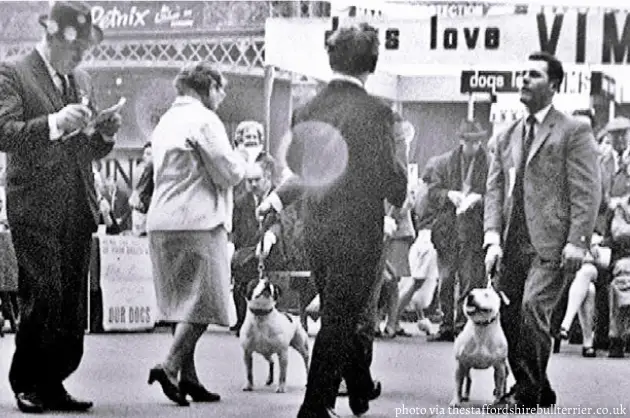
Pit Bulls and Staffies were once bred for their dogfighting capabilities. But as time progressed, so did feelings about dogfighting.
As people became increasingly aware of the harshness of such a “sport,” it eventually became abandoned and condemned by the UKC (United Kennel Club).
Unfortunately, the reputation of the American Pit Bull Terrier never recovered. It was continuously associated with dogfighting.
In return, the AKC (American Kennel Club) would not recognize the American Pit Bull Terrier as a breed. They were, however, willing to accept the Staffordshire Bull Terrier.
So, two dogs that were essentially the same breed just obtained different names.
WORTH A LOOK: Is the American Staffordshire Terrier A Pit Bull?
How To Tell A Staff From A Pit Bull
Physical Characteristics
There is no doubt that Pit Bulls and Staffies are very similar in appearance.
- Both breeds are strong, muscular, and solid in build. (see image above)
- They are both athletic, energetic, and playful.
- Both Pit Bulls and Staffies love to play and train at the park, but can also work hard.
- They are incredible diggers and can pull heavy loads when necessary.
- They are incredible athletes who are easy to train in sports like rally, flyable, and weight-pulls.
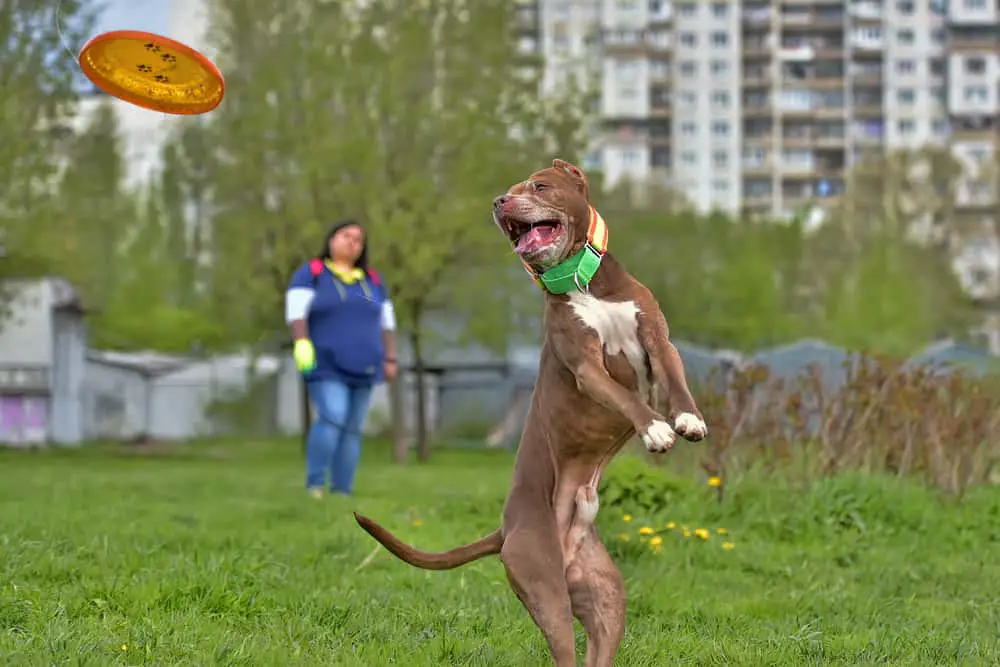
Both the American Pit Bull Terrier and the Staffordshire Bull Terriers are very energetic and require daily exercise to help them burn their energy.
With proper care, both the Pit Bull and that Staffordshire Bull Terriers have long lifespans of up to 14 years.
With that being said, they are both at increased risk of mange, heart disease, and elbow and hip dysplasia.
So, these are the answers you will get from people who think that Staffies and Pit Bulls are the same.
But what about those who say they are two different breeds?
Height & Weight Comparison
Many people will tell you that there are clear distinctions between these dogs.
Let’s take a look:
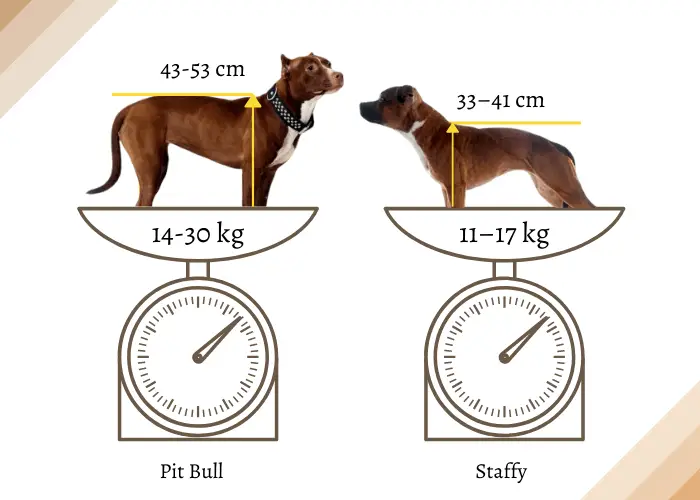
One of the main differences is the height.
According to the AKC, Staffies should stand between 14-16 inches in height. American Pit Bull Terriers, on the other hand, should stand between 17-21 inches tall.
As for weight, the ideal weight for a Staffy is considered to be between 24-38 pounds, whereas the ideal weight of a Pit Bull is between 27-60 pounds.
In other words, the Pit Bull is generally considered to be larger and heavier than the Staffordshire Bull Terrier.
Coat and Color
Their color and coat are often very similar. Both breeds have short, smooth coats.
According to the AKC, the only coat colors allowed for the Staffordshire Bull Terrier are blue, fawn, red, white, black, or brindle.
Pit Bulls, on the other hand, can be any color except for merle.
With that being said, Pit Bulls come in more colors than Staffies.
Head and Muzzle
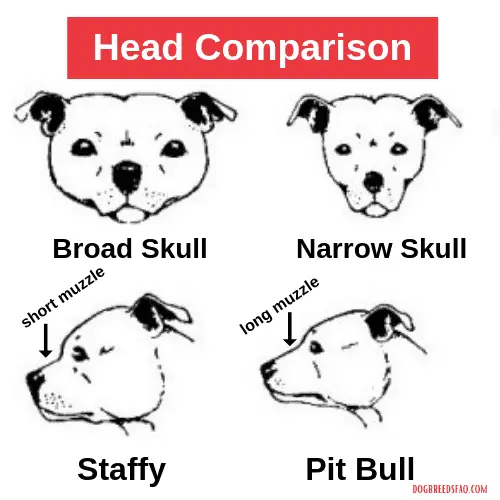
When it comes to the head size, the difference is a little more evident. The UKC breed standards state that both Pit Bulls and Staffies should have broad, straight, tapering muzzles.
“The American Pit Bull Terrier’s head is of medium length, flat, broadest at the ears skull, and a long muzzle.”
“The Staffordshire Bull Terrier’s head is short, with broad skull, very pronounced cheek muscles, and a short muzzle.”
– United Kennel Club
The difference is in the length of the muzzle & width of the skull.
According to breed standards, Pit Bulls should have a muzzle that is 2:3 the length of their head.
For Staffordshire Bull Terriers, there are no such regulations. Muzzles for Staffies can be longer or shorter than the 2:3 ratio given to Pit Bulls.
Temperaments and Behavior
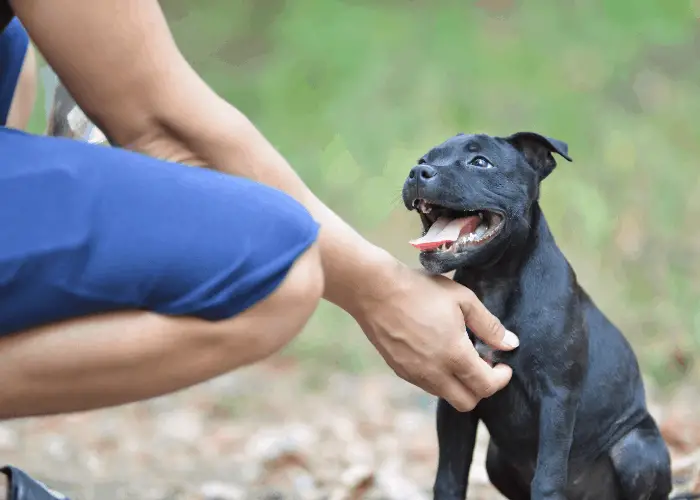
When it comes to temperament, all dogs are going to have their personality, even if they are the same breed.
With that being said, the United Kennel Club & American Kennel Club does lay out some temperament traits for Pit Bulls and Staffies:
- Pit Bulls are considered to be strong, confident, zesty, and eager to please their owners. Many animal shelter workers said that they are more volatile than Staffies.
- Staffies are tenacious, intelligent, trustworthy, courageous, and loving to their family. They are much more even-tempered than Pit bulls.
- Both breeds are very loving towards people but do require effective training and socialization in early life.
- Both breeds have a bad reputation for their history in dogfighting.
When improperly cared for, these dogs can both live up to their bad reputations. This is because they are both so eager to please their owners.
In other words, if the owners train the breeds to be vicious and dangerous, that is how they will grow to be.
But when trained to be loving and playful, Pit Bulls and Staffies can make some of the friendliest and affectionate pets in the world.

Both the Pit Bull and the Staffy make excellent family pets when loved and appropriately trained.
Yes, both breeds can make great pets but require an ideal type of owner to care for them.
Owners Best Suited For These Dogs Will Be:
1. Family Oriented And Loving.
They will be someone who wants a dog for companionship, not for protection.
Despite their rough and tough reputation, Staffies and Pitbulls often make horrible guard dogs.
This is because they are extremely loving and affectionate, even to strangers.
2. Experienced Owner.
Pit Bulls and Staffies can be very strong-willed, so they need an owner who is even more strong-willed and experienced in dog training.
3. Available.
As we mentioned before, Pit Bulls and Staffies require extensive training as puppies.
If you are extremely busy, these might not be the best breeds for you.
Both Staffies and Pit Bulls require someone who has plenty of time for training, socialization, and love.
Reputation & Perception:
The shadow of dogfighting looms large over the histories of the American Pit Bull Terrier and the Staffordshire Bull Terrier.
This brutal “sport,” which pitted dogs against each other in combat, was unfortunately popular in both the UK and the US during the 18th and 19th centuries.
Both breeds, known for their strength, agility, and at times, sheer tenacity, were prime candidates for such events.
The Impact of Dogfighting:
The association with dogfighting has left an indelible mark on the reputation of both breeds. While the cruel practice was eventually outlawed, the stigma persisted.
Many began to view these breeds as inherently aggressive and dangerous, a perception fueled by sensationalized media reports of dog attacks.
This stereotype was further exacerbated by individuals who sought out these breeds for their perceived aggressiveness, often neglecting proper training and socialization, leading to isolated incidents that further tarnished the breed’s reputation.
Modern-Day Perception:
Today, the narrative is slowly changing, but challenges remain. Animal activists, breed enthusiasts, and responsible dog owners have worked tirelessly to showcase the true nature of both Pit Bulls and Staffies.
They are loyal, affectionate, and often incredibly gentle, especially when raised in loving, attentive households.
However, breed-specific legislation in various regions still bans or restricts the ownership of these breeds, a testament to the lingering misconceptions.
Moreover, the modern-day challenges faced by these breeds aren’t just legislative.
Many shelters report higher numbers of Pit Bulls and Staffies compared to other breeds, a result of overbreeding, neglect, and abandonment.
Often misunderstood and maligned, these dogs face longer shelter stays and lower adoption rates.
Yet, amidst these challenges, there’s hope. Countless success stories of rescued and rehabilitated Pit Bulls and Staffies are powerful testimonials to their inherent goodness.
With proper training, socialization, and love, these breeds can and often become beloved family members, defying the stereotypes and proving that their troubled past doesn’t define their present or future.
Conclusion:
So back to our original question, are Pit Bulls and Staffies the same?
Some people will tell you YES.
They are the same breed who, because of their rough history, have just obtained different names.
Others will tell you NO.
While the two are very similar, they are more like cousins than siblings, and they do have some very distinct differences.
Today the AKC and the UKC do recognize the Staffies and Pit Bulls as two separate breeds, and their differences are outlined above.
Love to hear your thoughts…
Please LEAVE COMMENT.

References:
1. [^] “Staffordshire Bull Terrier.” Breed Standards: Staffordshire Bull Terrier | United Kennel Club (UKC), https://www.ukcdogs.com/staffordshire-bull-terrier.
2. [^] “Bull and Terrier.” Wikipedia, Wikimedia Foundation, 20 Sept. 2019, https://en.wikipedia.org/wiki/Bull_and_Terrier.
3. [^] “American Pit Bull Terrier.” Breed Standards: American Pit Bull Terrier | United Kennel Club (UKC), https://www.ukcdogs.com/american-pit-bull-terrier.

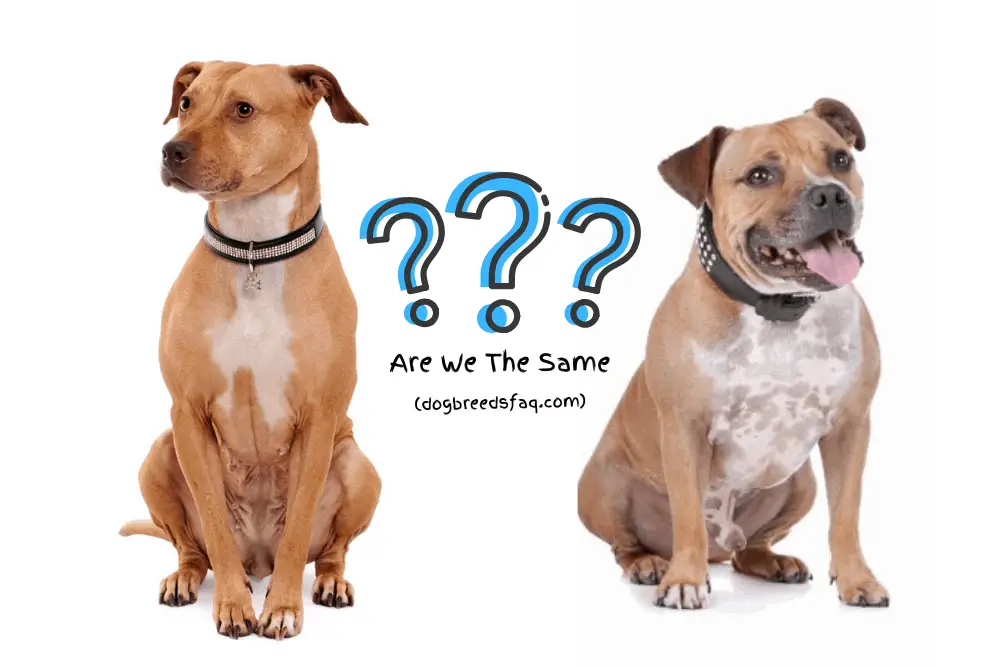
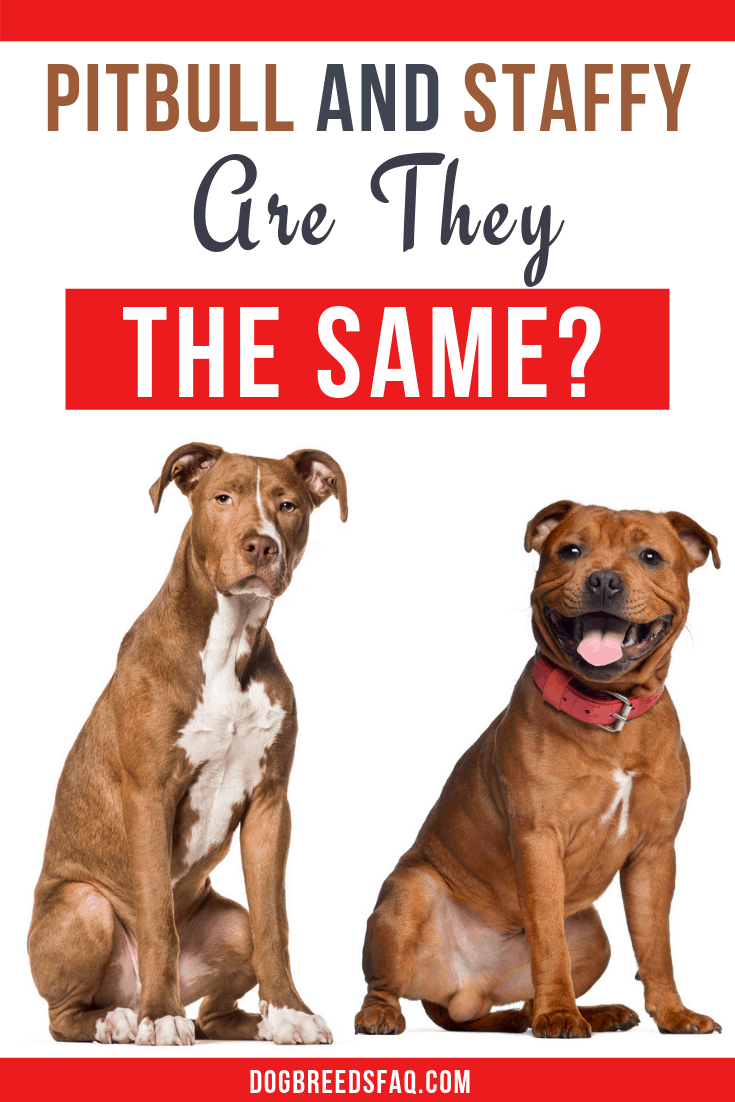
I do have a Strong dog but as far as to knows which breed exactly my female is ???, I got her,at the age of 6 y.o. from a not serious breeder who used her to make money. ??? Unfortunately there is very few serious breeder of these breeds and a lot of them breeds AST with APT or SBT and vice versa. At the end of the day , we loose the singularities that differ these breeds.
The only thing that matter for you owner is when you get any of these breeds, or something mix with it, be aware that your life style should be ready to welcome such a magnificent animal as they can give a lot but you have to give a lot too, in play time ,love time and training time,not to say,patience time.
They like kids, if you don’t give them a proper amount of attention and devotion they can turn temperamental, disobedient with an uncontrolled high level of energy or even depressed and sick.
Reggie ,strong dog lover
Thanks for the comment Rejean Gauthier.
Thanks James!
You’re a knob James. Did you not just read the preceding article (as well as just about EVERY other article written on the same subject)??!? You have obviously had a bad experience with a Pitbull that HADN’T been trained or socialised from a pup. You are separating the breeds by their “prey instinct” rather than the physical characteristics & genetics.
I have a staffy and she loves to cuddle with kids as close as they will allow her to be. She only barks when people first arrive and then of they pet her she is their best friend as long as they are there. She will chase anything for the heck of it but she doesn’t hurt them. Except for cats. Probably due to the fact that they scratch her for cornering them. People always do that double take and mistake her for a pitbull. But her character has shown she is a staffy and definitely fits the bill of nanny dog to a t. The dog is so docile with the kids it’s amazing how much they love them without the slightest bit of aggression. She is going on 9 years old now and I have no regrets in her except she was a very stubborn dog to train but she is a very good girl now and we will get a new one when she is gone though she will be missed hopefully it won’t happen anytime soon.
Staffies are one of the best dogs on the planet!
NO worries. I’m glad you like the article!
I had an American bulldog for 8 1/2 years.she developed a tumor n passed away.she broke my heart. I waited 2 years before I decided to get another dog. My nephew gave it to me. He had the mom n dad. He got them from a breeder in kansas. Loved that dog. After 2 years I saw this stephy in the neighbors community blog. This guy put a picture of her in the blog. I saw her n said .well she’s not a AB. But she resemble n AB.i went n got her. I felt relief like a weight of my shoulders. She was 7 months old n now she turns years old this month of March. She is my baby. She is all you say about them. Real smart dog. The kid said that she was a American English bulldog terrier. She is brown n white spots. To me the only thing that resemble the English bulldog is the was she stands. Her 2 front legs are bowedlegged..
Sorry for your loss. I’m glad you’ve moved on Larry. Enjoy your lovely dog!
She’s real hyper. But I love her. She’s cool. Loves cats n squirrels. I got 4 smaller dog that are rescue dogs. My wife wouldn’t get rid of them after a week. Their all barkers. She doesn’t really don’t get along with the only male dog that we have. .
Thanks for sharing your Pit Bull Story Larry!
Do your research. Man that pic is not a Pitbull next to the Staffy. It’s an English Bull Terrier.
That is a Staffordshire Bull Terrier NOT English Bull Terrier Man. Thanks for the comment.
Have they ever cross bread the pit bull and the staffie? I ask because I have what I was told was a staffie but after reading this my dog has traits of both breeds. Btw he is also my service dog and the very first bully breed dog to be registered as a service dog in San Jose, Ca. I’m just trying to figure out if maybe he is a little of both breeds?
Thanks for the nice comment Patrick Burke!